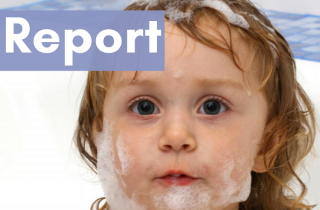Mixtures & Interactions
At a Glance
In our everyday lives, we are exposed to multiple repeated low doses of the same chemical and also to mixtures of exposures that may act together to increase risk of disease, including breast cancer. The social and biological contexts in which those exposures occur are important for understanding breast cancer risk. Some chemicals are used in multiple products and may also be present in air and water. In addition, many of the products we use routinely contain chemicals of concern. Characteristics such as age, genetics, diet, physical activity, alcohol use, smoking, and the social, economic, cultural and environmental context of early life may interact with exposures to chemicals and radiation to alter risk.
We know that low-dose exposures to chemicals that disrupt hormones can have particularly serious health effects.[1],[2] In addition, many low-dose exposures are continuous or occur throughout the day. For instance, people may be exposed to phthalates—which are found in both plastics and personal care products—when using shampoo, conditioner, lotions or soaps with fragrances; and when they consume foods kept in phthalate-containing storage containers. These repeated, low-dose exposures occur for an array of chemicals every day. Research suggests that exposure to different kinds of mixtures affects breast cancer risk,[3] but only a small number of those combinations have actually been tested.[4]
Even at low concentrations, environmental chemicals may increase the effects of natural estrogens. One study showed that various chemicals had additive effects with each other and with the natural estrogen, estradiol.[5] Similarly, at levels found in our environment, bisphenol A (BPA) significantly increased the effects of estradiol.[6] Studies of two different weakly estrogenic pesticides — dieldrin and toxophene — showed different effects depending on the doses used and the particular conditions of the experiments. [7],[8] Another study found clear additive effects from mixtures of four very different types of environmental chemicals including DDT (a pesticide residue), genistein (a plant estrogen), and 4-n-octylphenol and 4-nonylphenol (two surfactants).[9]
At the biological level, genes may make some women more vulnerable to certain environmental exposures. Several studies have reported an increased risk for developing breast cancer in women with either BRCA1 or BRCA2 mutations following exposure to medical radiation, either mammography or radiation therapy.[10],[11],[12],[13] Other genes can also make individuals more susceptible to different genetic, lifestyle, hormonal or environmental challenges.[14],[15],[16]
Race, ethnicity, socioeconomic status and other social factors also shape breast cancer risk. These interactions are complex, because access to health care, exposures to environmental chemicals,[17],[18],[19] access to healthy foods and safe spaces for physical activity, occupation, and community stress and security are affected by the built environment, social networks, geographic location, poverty[20] and race.[21] As a result, the actual causes of these disparities likely emerge from the complex social dimensions of class and race in the United States.[22] Socioeconomic status, race and ethnicity probably serve as markers for other activities or circumstances that influence the level of exposures to potentially toxic chemicals.[23]
Most data on disparities and exposure to chemicals of concern still use broad categories that brush over complex social causes of these disparities. According to CDC scientists, African American individuals have higher body-burden levels than whites or Mexican-Americans of many chemicals, including PCBs, mercury, lead, PAHs, dioxins and phthalates. Mexican-Americans have higher levels of the pesticides DDT/DDE, lindane and 2,4,5-TCP.[24] Yet many of these racial/ethnic differences may be explained, at least partially, by differences in economic resources.[25],[26] Varying body burdens of some chemicals, including bisphenol A (BPA) and polyfluoroalkyl chemicals (PFCs), both commonly found in household products, are associated with both race/ethnicity and socioeconomic status.[27]
Better understanding of the social factors and inequities underlying individual and group differences in health outcomes may support the development of strategies for prevention.
[1] Diamanti-Kandarakis, E. (2009). Endocrine-Disrupting Chemicals: An Endocrine Society Scientific Statement. Endocr Rev, 30, 293–342.
[2] Fenton, S. (2006). Endocrine-disrupting compounds and mammary gland development: Early exposure and later life consequences. Endocrinology, 147, 18–24.
[3] Kortenkamp A (2006). Breast cancer, oestrogens and environmental pollutants: a re-evaluation from a mixture perspective. Int J Androl, 29:193-198.
[4] Koppe JG, Bartonova A, Bolte G, et al. (2006). Exposure to multiple environmental agents and their effect. Acta Paediat, 95 (Suppl 453):106-113.
[5] Rajapakse, N., Silva, E., & Kortenkamp, A. (2002). Combining xenoestrogens at levels below individual no-observed-effect concentrations dramatically enhances steroid hormone action. Environ Health Persp, 110, 917–921.
[6] Rajapaske, N., Ong, D., & Kortenkamp, A. (2001). Defining the impact of weakly estrogenic chemicals on the action of steroidal chemicals. Toxicol Sci, 60, 296–304.
[7] Ramamoorthy, K., Wang, F., Chen, I., Safe, S., Norris, J., McDonnell, D., … Korach, K. (1998). Potency of combined estrogenic pesticides: Synergism between synthetic estrogens. Science, 275, 405–406.
[8] Arnold, S., Klotz, D., Collins, B., Vonier, P., Guillette, L. J., & McLachlan, J. (1996). Synergistic activation of estrogen receptor with combinations of environmental chemicals. Science, 272, 1489–1492.
[9] Foster, W., Younglai, E., Boutross-Tadross, O., Hughes, C., & Wade, M. (2004). Mammary gland morphology in Sprague-Dawley rats following treatment with an organochlorine mixture in utero and neonatal genistein. Toxicol Sci, 77, 91–100.
[10] Berrington de Gonzalez A, Berg CD, Visvanathan K, Robson M. Estimated risk of rradiation-induced breast cancer from mammographic screening for young BRCA mutation carriers. J Natl Cancer Inst. 2009;101:205-9.
[11] Jansen-van der Weide MC, Greuter MJW, Jansen L, Oosterwijk JC, Pijnappel RM, de Block GH. Exposure to low-dose radiation and the risk of breast cancer among women with a familial or genetic predisposition: A meta-analysis. Eur Radiol. 2010;20:2547-56.
[12] Pijpe A, Andrieu N, Easton DF, et al. Exposure to diagnostic radiation and risk of breast cancer among carriers of BRCA1/2 mutations: retrospective cohort study (GENE-RAD-RISK). 2012;345:e5660.
[13] Bernstein JL, Thomas DC, Shore RE, et al. Contralateral breast cancer after radiotherapy among BRCA1 and BRCA2 mutation carriers: A WECARE Study Report. Eur J Cancer. 2013;49:2979-85.
[14] Bradbury, A. R., & Olopade, O. I. (2007). Genetic susceptibility to breast cancer. Rev Endocr Metab Dis, 8(3), 255–267.
[15] Conde, J., Silva, S., Azevedo, A., Teixeira, V., Pina, J., Rueff, J., & Gaspar, J. (2009). Association of common variants in mismatch repair genes and breast cancer susceptibility: a multigene study. BioMed Cent, 9, 344.
[16] Silva I dos S, Wark PA, McCormack VA, et al. Ovulation-stimulation drugs and cancer risks: a long-term follow-up of a British cohort. Br J Cancer. 2009;100:1824-31.
[17] Evans, G. W., & Kantrowitz, E. (2002). Socioeconomic status and health: the potential role of environmental risk exposure. Annu Rev Publ Health, 23, 303–331.
[18] Forastiere, F., Stafoggia, M., Tasco, C., Picciotto, S., Agabiti, N., Cesaroni, G., & Perucci, C. A. (2007). Socioeconomic status, particulate air pollution, and daily mortality: differential exposure or differential susceptibility. Am J Ind Med, 50(3), 208–216.
[19] Quinn, M. M., Sembajwe, G., Stoddard, A. M., Kriebel, D., Krieger, N., Sorensen, G., … Barbeau, E. M. (2007). Social disparities in the burden of occupational exposures: results of a cross-sectional study. Am J Ind Med, 50(12), 861–875.
[20] Rauh, V. A., Landrigan, P. J., & Claudio, L. (2008). Housing and health: intersection of poverty and environmental exposures. Ann NY Acad Sci, 1136, 276–288.
[21] Brulle, R., & Pellow, D. (2006). Environmental justice: human health and environmental inequalities. Ann Rev Public Health, 27, 103–124.
[22] Krieger N, Löwy I, Aronowitz R, et al. (2005). Hormone replacement therapy, cancer, controversies, and women’s health: historical, epidemiological, biological, clinical, and advocacy perspectives. J Epidemiol Community Health, 59:740-748.
[23] Nelson, J. W., Scammell, M. K., Hatch, E. E., & Webster, T. F. (2012). Social disparities in exposures to bisphenol A and polyfluoroalkyl chemicals: a cross-sectional study within NHANES 2003-2006. Environ Health, 11, (10), art. No 10.
[24] CDC: Center for Disease Control and Prevention. (n.d.). Third National Report on Human Exposure to Environmental Chemicals. Atlanta: Center for Disease Control and Prevention.
[25] Borrell, L. N., Factor-Litvak, P., Wolff, M. S., Susser, E., & Matte, T. D. (2004). Effect of socioeconomic status on exposures to polychlorinated biphenyls (PCBs) and dichlorodiphenyldichloroethylene (DDE) among pregnant African-American women. Arch Environ Health, 59(5), 250–255.
[26] Bellinger, D. C. (2008). Lead neurotoxicity and socioeconomic status: conceptual and analytical issues. Neurotoxicology, 29(5), 828–832.
[27] Calafat, A., Ye, X., Wong, L.-Y., JA, R., & LL, N. (2008). Exposure of the U.S. population to bisphenol A and 4-tertiary-octylphenol. Environ Health Persp, 116, 2003–2004.
Types: Article




